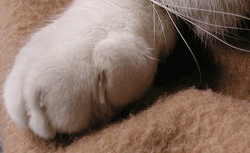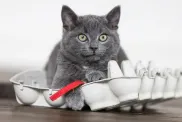Years ago no one blinked when someone had a cat declawed, but these days declawing is passionately debated. Still, some individuals are not aware of the seriousness and potential ramifications of declawing and make the decision without being fully informed. Unfortunately, declawing cannot be undone if the human later regrets the decision, so continued efforts at public education about the ins and outs of declawing is much needed. Ultimately, the decision to declaw should not be undertaken lightly.
Why People Declaw Cats
Cats scratch. It is an inherent and natural behavior. Some people tolerate it well and laugh at the scratched furniture. Others have a lower threshold and just can’t stand it. Cats can do a number on furniture, curtains, and wood trim. A cat’s scratching can even threaten the health of an immune-compromised family member, someone on blood thinners, or a person with certain other health problems.
Declawing – Not a “Minor” Medical Procedure
Declawing a cat is not equivalent to clipping a cat’s nails or a permanent manicure. Declawing (formally known as onychectomy) is serious surgery that potentially involves pain and, in some cases, complications. The surgery is done under anesthesia and involves surgically amputating the cat’s third phalanges (toe bones) and the attached claws with sterilized nail trimmers, scalpel blades, or surgical lasers.The surgery may be performed on only the front paws or all four. People talk about behavioral changes after surgery, though that may not be scientifically proven so much as anecdotally rumored.
Argument Against Declawing
Opponents of declawing will say that the procedure is akin to having the tips of each of your fingers, and possibly your toes, amputated at the top joint. Many people believe that declawing should never be performed. In fact, European countries do not allow it, except for medical situations, nor does the West Hollywood, California. And, the Cat Fanciers’ Association forbids showing declawed cats.
While the American Veterinary Medical Association has not taken a position that is completely opposes the practice, many individual veterinarians refuse to do it.
Arguments that Support Declawing
Some support declawing as a viable option for cases of medical necessity (for the human’s or cat’s health depending on the situation) or loss of the home. They argue that declawing is a better than relinquishing the cat to a shelter (cats still face high euthanasia rates), forcing the cat to live outdoors (many dangers) or euthanizing the cat. Generally, supporters do urge guardians to try all other alternatives first and to declaw only as the last resort.
Are There Alternatives to Declawing?
Humans can take a number of steps to reduce the negative effects of a cat’s scratching and to redirect the cat’s scratching targets. First, trimming the cat’s claws using special clippers is a good practice. Your veterinarian can show you how and advise on how to proceed with very wiggly cats.
Second, scratching posts and boxes come in many varieties and price ranges, from simple corrugated cardboard floor boxes to elaborate multi-tiered cat condos. Third, some people may find nail caps helpful.
Finally, training your cat with treats for redirected behavior, or using the water-filled squirt bottle for scratching the furniture may help. The degree of effectiveness varies from cat to cat and may not eliminate scratching altogether. In fact, declawed cats often still scratch, they just don’t have the damaging claws so the behavior becomes harmless.









